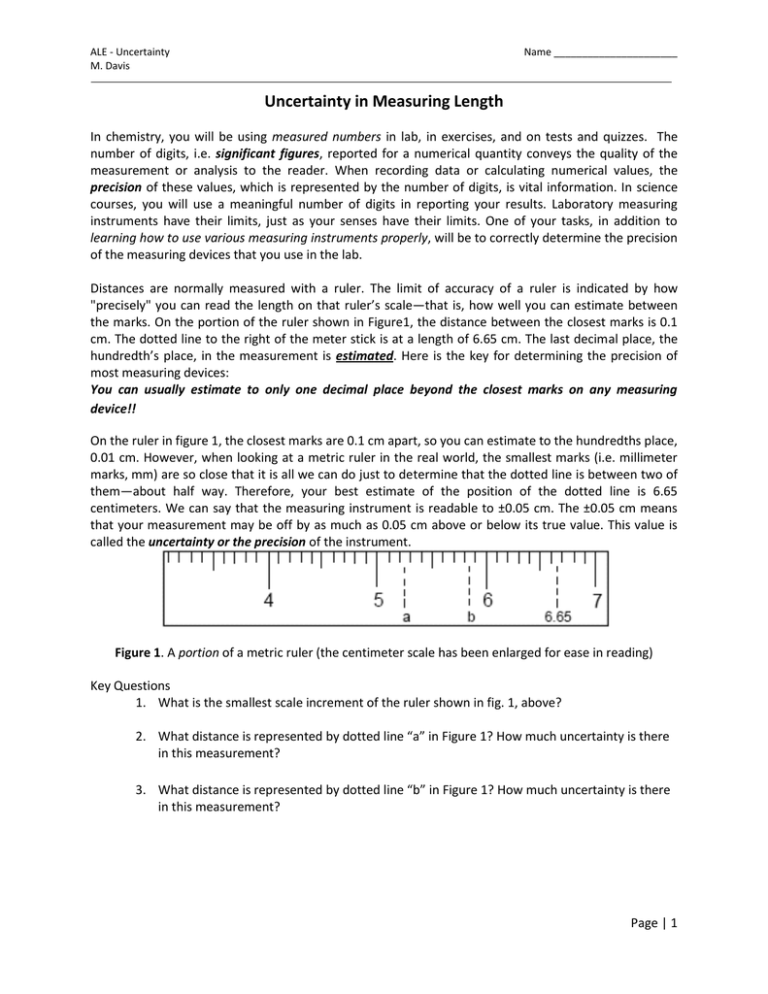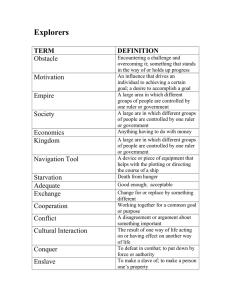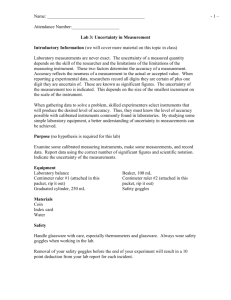Uncertainty in Measuring Length
advertisement

ALE - Uncertainty M. Davis Name ______________________ Uncertainty in Measuring Length In chemistry, you will be using measured numbers in lab, in exercises, and on tests and quizzes. The number of digits, i.e. significant figures, reported for a numerical quantity conveys the quality of the measurement or analysis to the reader. When recording data or calculating numerical values, the precision of these values, which is represented by the number of digits, is vital information. In science courses, you will use a meaningful number of digits in reporting your results. Laboratory measuring instruments have their limits, just as your senses have their limits. One of your tasks, in addition to learning how to use various measuring instruments properly, will be to correctly determine the precision of the measuring devices that you use in the lab. Distances are normally measured with a ruler. The limit of accuracy of a ruler is indicated by how "precisely" you can read the length on that ruler’s scale—that is, how well you can estimate between the marks. On the portion of the ruler shown in Figure1, the distance between the closest marks is 0.1 cm. The dotted line to the right of the meter stick is at a length of 6.65 cm. The last decimal place, the hundredth’s place, in the measurement is estimated. Here is the key for determining the precision of most measuring devices: You can usually estimate to only one decimal place beyond the closest marks on any measuring device!! On the ruler in figure 1, the closest marks are 0.1 cm apart, so you can estimate to the hundredths place, 0.01 cm. However, when looking at a metric ruler in the real world, the smallest marks (i.e. millimeter marks, mm) are so close that it is all we can do just to determine that the dotted line is between two of them—about half way. Therefore, your best estimate of the position of the dotted line is 6.65 centimeters. We can say that the measuring instrument is readable to ±0.05 cm. The ±0.05 cm means that your measurement may be off by as much as 0.05 cm above or below its true value. This value is called the uncertainty or the precision of the instrument. Figure 1. A portion of a metric ruler (the centimeter scale has been enlarged for ease in reading) Key Questions 1. What is the smallest scale increment of the ruler shown in fig. 1, above? 2. What distance is represented by dotted line “a” in Figure 1? How much uncertainty is there in this measurement? 3. What distance is represented by dotted line “b” in Figure 1? How much uncertainty is there in this measurement? Page | 1 ALE - Uncertainty M. Davis Name ______________________ Exercises (Use units and the correct number of “significant figures” for all numerical answers!) Figure 2 – a portion of a cm ruler 1. What is the smallest increment on the centimeter ruler above? 2. What is the length of the dark line in the figure above? 3. What is the uncertainty in the measurement? Figure 3 – a portion of a cm ruler 4. What is the smallest increment on the centimeter portion of the ruler above? 5. What is the length, in centimeters, of the dark line in the figure above? 6. What is the uncertainty in this measurement? 7. Find a metric ruler. What is the length, in cm, between the closest marks on your ruler? 8. To what decimal place is your ruler precise? 9. What is the length of this page in cm? 10. What is the width of this page in cm? 11. How much uncertainty, in cm, is there in your measurements? Page | 2 ALE - Uncertainty M. Davis Name ______________________ Uncertainty in Measuring Volumes of liquids When you measure liquids in the chemistry laboratory, the volume of the liquid is usually measured in liters (L) or milliliters (mL). A graduated cylinder is most often used to measure the volumes in lab. You may also use a buret to measure the volume of liquid you deliver to a beaker or flask. Regardless of the device you use to measure a liquid, you must how to read the volume. Most of the liquids you will measure are comprised of molecules that ‘stick’ to each other and stick to the glass of the device. This characteristic will form a dip or bend on the surface of the liquid called a meniscus. To determine the volume in a glass device by reading the meniscus, you must ensure the device is level and then bring Figure 4 – a graduated cylinder your eye level (even) with the bottom of the meniscus. You must read the level of the liquid at the lowest point of the meniscus. As with the measurements involving the rulers above, you must read to the proper number of digits. Complete the following exercises. 1. What is the smallest scale increment for the 100 mL graduated cylinder shown in figure 5? 2. What is the volume of the liquid in the graduated cylinder in figure 5? 3. How much uncertainty is there in this measurement? Figure 5 – a 100 mL graduated cylinder Page | 3 ALE - Uncertainty M. Davis Name ______________________ 1. What is the smallest scale increment for the 10 mL graduated cylinder shown in figure 6? 2. What is the volume of the liquid in the graduated cylinder in figure 6? 3. How much uncertainty is there in this measurement? Figure 6 – a 10 mL graduated cylinder The Buret In lab you will use a specialized piece of equipment called the buret. It is a skinny glass tube that is designed to deliver specific amounts of a solution as part of the experimental procedure. A buret is shown in figure 7. Burets are different than other measure devices in that they are designed to be read from the top down! When you fill the buret with solution, the initial volume should be at or close to 0.00 mL. As a to deliver device, it is designed to measure how much liquid you drain out of the bottom. For example, if your start volume is 0.00 mL and you drain the liquid out of the buret to a final volume of 15.65 mL, you have added a volume of 15.65 mL to a vessel. This is calculated as: Final Volume – initial volume. It is IMPERATIVE that you remember that the buret is read from the TOP DOWN. You will always read it from a low number to a high number. Figure 7 – a buret Keep this in mind as you answer the following questions. 1. What is the smallest scale increment on the buret shown in figure 8? 2. To what decimal place should you report volumes that you read on the buret? 3. What is the initial volume reading in the buret shown in figure 8? (remember to read the buret from the top down) Figure 8 – initial volume Page | 4 ALE - Uncertainty M. Davis Name ______________________ 4. Figure 9 shows the final volume of the solution after a particular lab experiment has been completed. What is the final volume that you would record in your data table. 5. What is the total volume that has been added between figures 8 and 9? To how many decimal places should you record your answer? Figure 9 – final volume Page | 5


